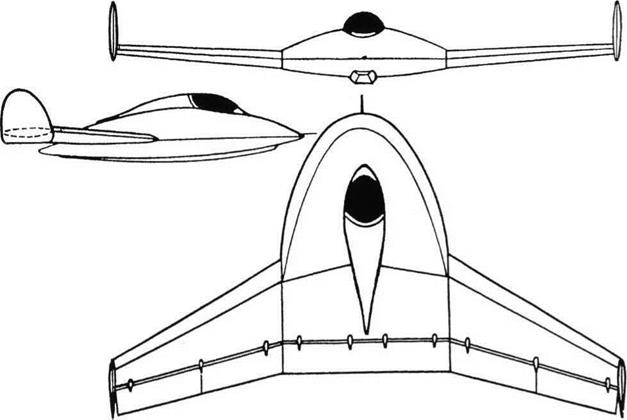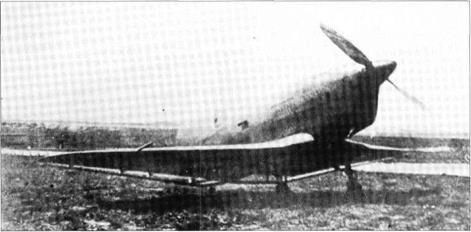BICh-18 Muskulyot
Purpose: To attempt once more to fly on human muscle power.
Design Bureau: B I Cheranovskii.
Undeterred by the total failure of BICh-16, Cheranovskii persevered with the idea of flying like a bird and designed the totally different BICh-18. The name meant ‘muscle-power’. On 10 th August 1937 pilot R A Pishchuchev, who weighed 58kg (1281b), glided 130m (4261/2ft) off a bungee launch, without pedalling. He then did a pedalling flight, achieving six wing cycles. He reported ‘noticeable forward thrust’, and flew 450m (1,476ft). Sustained flight was considered impossible.
The BICh-18 vaguely resembled a performance sailplane with a cockpit in the nose and conventional tail. Much of the structure was balsa. There were two wing sets, comprising the lower left and upper right wings forming one unit and the upper left and lower right forming the other. Both sets were mounted on pivots on top of the fuselage and arranged to rock through a ±5° angle by cockpit pedals. As the wings rocked, their tips never quite touching, the portion of each wing aft of the main spar was free to flap up and down to give propulsive thrust. One report states that the outer trailing-edge portions were ailerons.
If the evidence is correct this odd machine was one of the few human-powered aircraft to have achieved anything prior to the 1960s.
Dimensions
Span 8.0m 26 ft 3 in
Length 4.48m 14 ft 814 in
Wing area 10.0m2 108ft2
Weights
Empty 72 kg 1591b
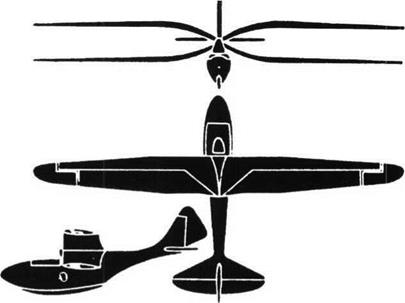
![]() Loaded 130kg 287 Ib
Loaded 130kg 287 Ib
Purpose: To test a small sporting aircraft of tailless design.
Design bureau: B I Cheranovskii.
This attractive little machine was rolled out on skis in late 1937 and first flown in 1938. Later in that year it was fitted with a more powerful engine, and with wheel landing gear. Extensive testing, which included sustained turns at about 35° bank at different heights, showed that the BICh-20 was stable and controllable, and also could land very slowly.
This aircraft was again a wooden structure, with ply over the leading edge and the vestigial fuselage. The wing marked a further change in aerodynamic form: having started with ‘parabola’ designs, Cheranovskii switched to delta (triangular) shapes, and with the BICh-20 adopted a more common form with straight taper, mainly on the leading edge. Trailing-edge controls comprised inboard elevators and outboard ailerons, with prominent operating levers. To enter the cockpit the pilot hinged over to one side the top of the fuselage and integral Plexiglas canopy which formed the leading edge of the fin. The aircraft was completed with Chera – novskii’s ancient British 18hp Blackburne engine, in a metal cowling, and with sprung ski landing gear. It was later fitted with wheels, including a tailwheel, and a 20hp French Aubier-Dunne engine.
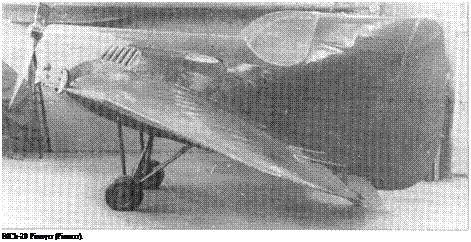
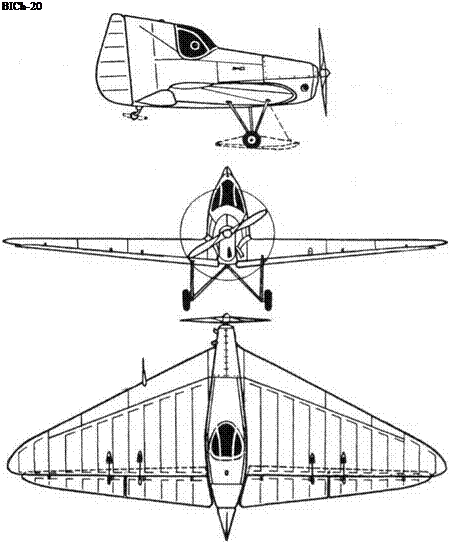 All known records suggest that this aircraft was completely successful.
All known records suggest that this aircraft was completely successful.
|
Dimensions Span Length, original re-engined Wingarea |
6.9m 3.5m 3.56m 9.0 nf |
22fl8in Ilft6in 11 ft 8H in 97ft2 |
|
Weights |
||
|
Empty, original |
176kg |
38815 |
|
re-engined |
181kg |
399 Ib |
|
Loaded, original |
280kg |
6171b |
|
re-engined |
287kg |
633 Ib |
|
Performance |
||
|
Maximum speed, original |
160km/h |
99 mph |
|
re-engined |
166km/h |
103 mph |
|
Service ceiling |
4,000 m |
13,120ft |
|
Range |
320km |
199 miles |
|
Landing speed |
49km/h |
30 mph |
![]()
|
||||||||||||||||||||||||
|
||||||||||||||||||||||||
Purpose: To use the tailless concept in a more powerful aircraft for racing.
Design Bureau: B I Cheranovskii.
By the late 1930s Cheranovskii was confident that he could apply his unusual configuration, with no separate horizontal tail, to aircraft intended to reach much greater speeds. For the big All-Union race organised by Osoaviakhim to take place in August 1941 he designed a minimalist aircraft broadly like the BICh-20 but with a far more powerful engine. Also designated SG-1, from Samolyot Gonochnyi, aeroplane for racing, it was completed in 1940, but not flown until June 1941. The Ger
man invasion of 22nd June resulted in the race being cancelled.
With a configuration almost identical to that of the BICh-20, the BICh-21 was likewise all-wood, with polished shpon skin except over the metal engine cowl and cockpit canopy. Unlike the BICh-20 the wing was made as a centre section (with anhedral) and outer panels. This in turn resulted in a different arrangement of trailing-edge controls, these having reduced chord, with a significant portion ahead of the trailing edge of the wing, with the elevators divided into two
parts on each side. The engine was an MV-6, the Bessonov licence-built Renault with six aircooled cylinders, rated at 270hp. It drove an imported Ratier two-blade two-pitch (fine or coarse) propeller. A small fuel tank was inside each side of the centre section. Immediately outboard of these were the landing gears, which retracted backwards under pneumatic pressure.
No records survive of this aircraft’s handling or of its fate.
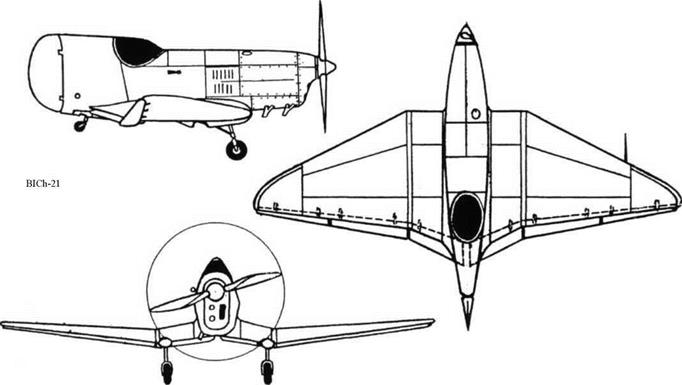
![]()
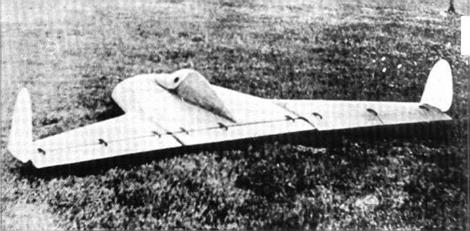

![]()
Purpose: To investigate a new aerodynamic configuration.
Design Bureau: B I Cheranovskii, by this time working at the MAI (Moscow Aviation Institute).
From 1947 Cheranovskii headed an OKB at the MAI, whose excellent facilities he used in a series of tailless projects. This glider was designed in winter 1948-49, and test flown by IA Petrov at Tushino from 17th July 1949.
Having progressed from the ‘parabola’ to a form of delta and then to a wing of normal tapered shape, this glider comprised a broad flat lifting fuselage, to which were attached conventional wings with modest sweepback. A further innovation was to use more conventional trailing-edge controls, mounted on the wing instead of below it. The original Che – 22 drawings show no vertical surfaces whatever, but later fixed fins were added on the wingtips.
Flight testing appeared to go well, and in late 1949 the DOSAV repair shops tooled up to put the Che-22 into production. Unfortunately, while testing the first to come off the assembly line Petrov crashed and was killed, and production was abandoned.
Performance
Not recorded, but ‘aerodynamic efficiency’ (lift/drag ratio) was 18.
